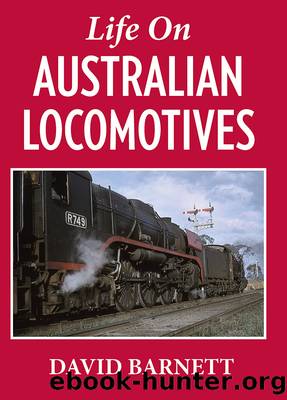Life on Australian Locomotives by David Barnett

Author:David Barnett [Barnett, David]
Language: eng
Format: epub
Publisher: Rosenberg Publishing
Published: 0101-01-01T00:00:00+00:00
18 Hamilton
I was still the junior man in the shed and this was reflected in the number of times I was rostered firing. This was generally once a week, on a Saturday. The remaining five or six days were either spent, cleaning, hostling or lighting up. This was the pattern for about two months. Then, on the approach to Easter, I was temporarily transferred to Hamilton. On the Thursday prior to Good Friday, I travelled on the 1.22 pm rail motor from Ararat and reported to the Hamilton loco foreman by telephone in the Hamilton signal box. I was required at the depot immediately. This was located at Coleraine Junction, a good half a mile from the station. Fortunately, an engine was heading that way and I rode on it. On making myself known, I was referred to driver Lind, for whom I was to fire on the 5.5 pm Ararat goods. He was with our engine, oil-burning J534. This was sitting on the turntable. âSlap a bit of oil around her, will you,â he said. After oiling up, I took water and oil and we were ready to proceed to Hamilton yard. We arrived there in plenty of time for a leisurely brake test and a cup of tea, using the billy boiler made by Jack Jones two month earlier. We got away on time with a manageable load of 300 tons. J534 proved more than equal to the task and Mr Lind didnât hesitate to explore its talents. With evening closing in, we stormed over the Strathkellar Bank to the sound of a magnificent rhythmic exhaust, made all the easier to achieve after 10 shovelfuls of sand had been put through the tubes. Grades were no more than an occasion to hear a continuous, clipped exhaust, which became more strident as the cutoff was lengthened. Speed was often around 40 mph, and when worked hard uphill at 30 mph J534 produced a most beautiful sonorous staccato that was a delight to hear. And it steamed like a breeze. Use of the injector made very little difference to the steam gauge.
We were running under clear signals, and with hand staff exchanges made at around 20 mph, we ran non-stop to Willaura. While taking water there, our changeover, the 6.35 pm ex Ararat arrived. Bill Eagan was driving and Max May firing R731, with a load of only 286 tons. 731 came in blowing off, and on changing over Max May triumphantly affirmed, âThis oneâs going like a beauty.â They had swept the footplate clean and we entered a cab where everything was in order. Darkness had now replaced evening and 731âs headlight showed us the way ahead. There was no breeze and the air was cool. Light from the full moon bathed the countryside in a soft, almost delicate illumination. Having received the appropriate staff, we whistled up the guard and got under way. At the slightest sniff of coal, R731âs steam gauge needle bounded upwards. Keeping the water level where you wanted it was a picnic.
Download
This site does not store any files on its server. We only index and link to content provided by other sites. Please contact the content providers to delete copyright contents if any and email us, we'll remove relevant links or contents immediately.
| Automotive | Engineering |
| Transportation |
Whiskies Galore by Ian Buxton(41529)
Introduction to Aircraft Design (Cambridge Aerospace Series) by John P. Fielding(32888)
Small Unmanned Fixed-wing Aircraft Design by Andrew J. Keane Andras Sobester James P. Scanlan & András Sóbester & James P. Scanlan(32573)
Craft Beer for the Homebrewer by Michael Agnew(17933)
Turbulence by E. J. Noyes(7700)
The Complete Stick Figure Physics Tutorials by Allen Sarah(7138)
Kaplan MCAT General Chemistry Review by Kaplan(6595)
The Thirst by Nesbo Jo(6435)
Bad Blood by John Carreyrou(6274)
Modelling of Convective Heat and Mass Transfer in Rotating Flows by Igor V. Shevchuk(6222)
Learning SQL by Alan Beaulieu(6035)
Weapons of Math Destruction by Cathy O'Neil(5829)
Man-made Catastrophes and Risk Information Concealment by Dmitry Chernov & Didier Sornette(5646)
Digital Minimalism by Cal Newport;(5389)
Life 3.0: Being Human in the Age of Artificial Intelligence by Tegmark Max(5184)
iGen by Jean M. Twenge(5161)
Secrets of Antigravity Propulsion: Tesla, UFOs, and Classified Aerospace Technology by Ph.D. Paul A. Laviolette(4990)
Design of Trajectory Optimization Approach for Space Maneuver Vehicle Skip Entry Problems by Runqi Chai & Al Savvaris & Antonios Tsourdos & Senchun Chai(4839)
Electronic Devices & Circuits by Jacob Millman & Christos C. Halkias(4748)
